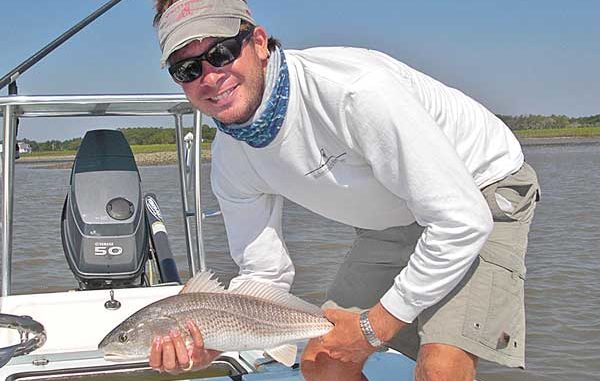
Football, deer hunting and back-to-school activities can dominate the early fall, but targeting redfish in shallow water can provide both the challenge of the hunt and the thrill fooling a fish with an artificial bait.
It is still plenty hot in September — if you don’t believe me, just head to a dove field — and the freight train that is the red drum fishery stays right on track into October. Live bait is still in the estuaries, and the water is still a bit muddy when the currents are at their strongest, but a change is on the way. Water clarity will improve early on in skinny water, and bait will get scarce, challenging anglers to catch their redfish on artificial baits.
Capt. Graham Hegamyer of Southern Tail Charters (843-991-8372) is one of the young guns in the Charleston inshore fleet. He runs out of the Isle of Palms Marina and specializes in fishing around low tide in the shallow waters found everywhere along the Intra-coastal Waterway. His infatuation with skinny-water fishing led him to purchase a specialty boat just for that purpose.
His 18-foot East Cape Canoe was custom-built in Orlando, Fla., earlier this year. It has a flat bottom and three skegs on the hull that help it track when running low water in between oyster beds. He chose a 2-stroke, 50HP Yamaha outboard because it is much lighter than a 4-stroke. Parts of the boat are made of Kevlar, which also reduces weight, so that Hegamyer can use his push-pole to maneuver in as little as six inches of water — and you might be surprised how many redfish hang out in these shallow waters.
Hegamyer uses a Power Pole — an automated dagger that sticks into the bottom to stop the boat when he pushes a button on his remote control. “Whether you are drifting with the tide or the wind, the Power-Pole allows you to stop the boat without having to take your eye off of a school of redfish. I can lay my push pole in the ‘pole caddy’and be casting my lure to the closest fish in no time.”
Using a flats boat allows fishermen to get closer to fish, but what artificial baits should be pitched in their direction? Hegamyer’s first choice is a 2-inch Gulp! peeler crab in Texas Chicken color rigged on a 3/0 circle hook tied with a snell knot. He also likes the 4-inch Gulp! swimming mullet in chartreuse or lime tiger. A popular fisherman’s saying is, “If it ain’t chartreuse, then it ain’t no use!”
Fishermen can add a sliding weight to their line if they want to increase casting distance; another benefit of a slider is that when the fish pick a bait up off the bottom, they don’t feel the sinker.
Can you use a float in the shallows? You bet. Even in skinny water, a float can help to keep a bait slightly elevated, and the click/clack noise produced when twitching a float can be enough to make a “nearby” redfish come and take a look.
Fly-fisherman hold an advantage in skinny water because the presentation of a fly is much more subtle that a weighted jerkbait or any other lure. Hegamyer says he keeps it simple and basic when it comes to flies; he advises using something like an olive-and-Clouser minnow. When a fish comes to the boat, handle it with care, using either a boga-grip or a rubber net that won’t rub the slime off. Most redfish are caught and released these days by recreational anglers keenly aware that redfish are a fragile component of our natural resources, and that only later in their life cycle do they become breeders.
During the HT3 Redfish Tour, Hegamyer had the redfish to himself in a super-shallow area, casting a 8-weight Sage fly rod. Other boats had been in his “honey hole” earlier in the day, but as the tide ebbed out to a -0.3, those boats had to back off or take a chance on getting stuck.
On one retrieve, a redfish that made the water boil was so shallow that it’s mouth broke the water’s surface — but Hegamyer didn’t get a good hookset.
Hegamyer said redfish miss baits on a lot of strikes because they’re not visual feeders, feeding more by smell. Their mouth is on the bottom of their head making it difficult for them to look up and hit something higher in the water column.
Another plus to being back in the shallows at dead low tide is that when the water starts to come back in, more redfish will return, and they won’t be expecting any anglers dead ahead. Rather, they are focused on getting out of any water deep enough for a predatory dolphin to use, and getting into the safety of skinny water.



Be the first to comment